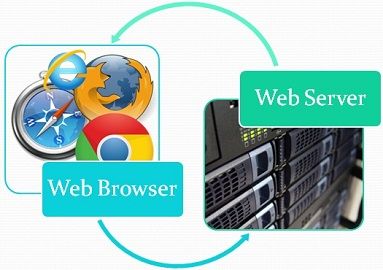Difference Between Web Browser and Web Server

Difference between Web browser and Web serverThe web browser is an application program that displays a www document. It usually uses other internet services to access the document.
Web server is a program or a computer that can provide services to other programs called clients.
The main difference between a Web browser and a Web server is that Web browser requests for the document and services, and act as an interface between a client and a server which displays the web content. On the other hand, Web server accepts, approve, and response to the request made by a web browser for a web document.
When a user asks a browser to get a web page, the browser parcels up this instruction with the help of protocol called the Transmission Control Protocol (or TCP). TCP is a transport (layer) protocol, which provides a reliable transmission format for the instruction. Its job is to confirm the correct sequence of the entire message so that it could be bundled up for transmission (and also that it is correctly unpacked and put back together after it arrives at its destination).
But, before parcels of data are sent out over the network uniquely, they need to be addressed. Thus a second protocol called Hypertext Transfer Protocol ( or HTTP) puts a unique address label on it. HTTP is the protocol employed the World Wide Web in the transfer of information from one computer to another – when you see URL prefixed with http:// you can immediately know that the internet protocol being used in HTTP.
The message that goes from the web browser to the web server is known as HTTP request. When the web server receives this request, it searches its stores to find the appropriate page. If the web server is able to locate the page, it parcels up the HTML contained within (using TCP or some other transport layer protocol), addresses these parcels to the browser (using HTTP), and transmit them back across the network.
If the web server is unable to find the requested page, it sends a page containing an error message (i.e., Error 404 – page not found)- and it parcels up the dispatches that page to the browser. This message received from the web server by the browser is called the HTTP response.
Content: Web Browser Vs Web Server
Comparison Chart
Definition
Key Differences
Conclusion
Comparison Chart
BASIS FOR COMPARISON
WEB BROWSER WEB SERVER
Basic Software which acts as an interface between server and client, and displays web documents to the client. Software and a system which maintain the web applications, generate response and accept clients data.
Primary role Send HTTP request and get HTTP response. Get HTTP requests and send HTTP responses.
Processing Models There doesn’t exist any processing model. Process based, Thread based and Hybrid.
Definition of Web Browser
A Web browser can be considered as a utility which client uses to access web services and documents from the server. There are various types of browsers are in use, for example, the default browser for windows platform is internet explorer, similarly for apple device default browser is Safari. Although, there are other browsers also like Google Chrome, Mozilla Firefox, opera and UC.
Browser Architecture :
There are numerous vendors offer several kinds of browsers commercially, the basic work of which is to display a web document. All the browsers you use employs almost the same architecture.
Each browser is divided into three parts, i.e., a controller, client program, and interpreters.

Controller gets the input by the way of a keyboard or a mouse and accesses the document by using client program.
While acquiring controller the document utilizes interpreters, to display the document on the screen.
At last the client program which could be any of the methods (or protocols) like HTTP, FTP, or TELNET.
Depending on the type of document, an interpreter can be HTML or Java.
The grouping of documents in the WWW is based on the instant when the content is created and classified into three categories: Static, dynamic, and active.
Definition of Web Server
Web Server is a piece of software running on a computer whose primary job is to distribute web pages to users whenever they demand it and provides an area in which to store and organise the pages of the website.
The machine that executes the web server software can be a remote machine placed at the other side of your network or even on the other end of the globe, or it be your very own personal computer at home. We also introduced the idea that the user’s browser was the client in this relationship.
Web Servers Processing Model
Process based servers have multiple single-threaded processes.
Thread based servers have a single multithreaded process.
Hybrid servers use multiple multithreaded processes.
Key Differences Between Web Browser and Web Server
Web browser accesses information provided by Web servers through the help of protocols.
The web browser sends HTTP request and gets the HTTP response. In contrast, a Web server gets HTTP requests, and it generates responses.
The web server has three processing models – process based, thread based and Hybrid. As against, a web browser doesn’t have any processing models.
Conclusion:
A web browser is an application software which acts as an interface between server and client and allows us to view and explore documents on the internet. While web server is a computer which is used for storing and hosting the web content. Furthermore, it handles HTTP requests generated by client with the help of a browser and responds back to the client.



